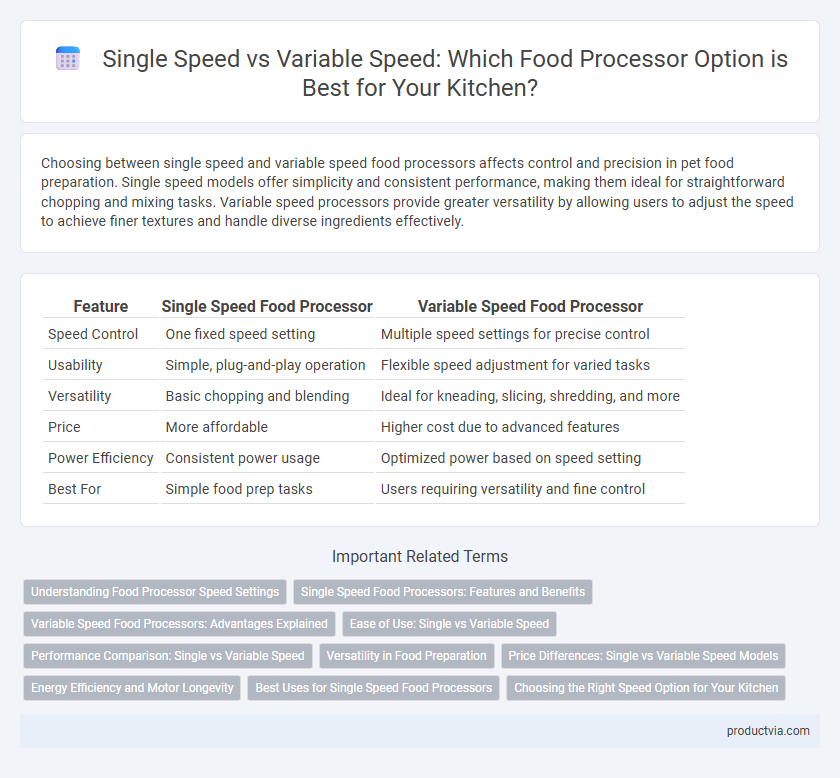Choosing between single speed and variable speed food processors affects control and precision in pet food preparation. Single speed models offer simplicity and consistent performance, making them ideal for straightforward chopping and mixing tasks. Variable speed processors provide greater versatility by allowing users to adjust the speed to achieve finer textures and handle diverse ingredients effectively.
Table of Comparison
| Feature | Single Speed Food Processor | Variable Speed Food Processor |
|---|---|---|
| Speed Control | One fixed speed setting | Multiple speed settings for precise control |
| Usability | Simple, plug-and-play operation | Flexible speed adjustment for varied tasks |
| Versatility | Basic chopping and blending | Ideal for kneading, slicing, shredding, and more |
| Price | More affordable | Higher cost due to advanced features |
| Power Efficiency | Consistent power usage | Optimized power based on speed setting |
| Best For | Simple food prep tasks | Users requiring versatility and fine control |
Understanding Food Processor Speed Settings
Single-speed food processors provide consistent power ideal for simple tasks like chopping and pureeing, ensuring reliability and ease of use. Variable-speed food processors offer greater control, allowing adjustments to speed settings for precision in slicing, shredding, and mixing various ingredients. Understanding these speed settings helps optimize food texture and consistency, enhancing culinary outcomes based on specific recipe requirements.
Single Speed Food Processors: Features and Benefits
Single speed food processors offer consistent power and simplicity, making them ideal for straightforward food prep tasks like chopping, blending, and pureeing. Their fixed speed setting ensures stable motor performance, enhancing durability and ease of use without the complexity of multiple controls. These models often feature streamlined designs, lower cost, and energy efficiency, appealing to users seeking reliable performance with minimal maintenance.
Variable Speed Food Processors: Advantages Explained
Variable speed food processors offer precise control over processing intensity, enabling users to achieve desired textures from coarse chopping to fine pureeing. This flexibility enhances versatility, allowing one appliance to handle a wide range of ingredients and recipes efficiently. Compared to single speed models, variable speed processors reduce the risk of over-processing and improve overall cooking outcomes.
Ease of Use: Single vs Variable Speed
Single speed food processors offer straightforward operation with a single setting, making them ideal for users seeking simplicity and quick tasks. Variable speed food processors provide enhanced control, allowing users to adjust processing speed for different ingredients and textures, which improves precision but can require a learning curve. Ease of use depends on the user's preference for either quick, consistent performance or customizable, versatile processing.
Performance Comparison: Single vs Variable Speed
Single speed food processors offer consistent power ideal for straightforward tasks such as chopping and mixing, while variable speed models provide greater control for precision in delicate preparations and complex recipes. Variable speed processors adapt performance to different ingredients and textures, enhancing versatility and reducing the risk of over-processing. Choosing between single and variable speed depends on the user's culinary needs, with variable speed delivering superior performance for varied and intricate food processing tasks.
Versatility in Food Preparation
Variable speed food processors offer enhanced versatility in food preparation by allowing precise control over texture and consistency, accommodating tasks from delicate chopping to heavy-duty kneading. Single speed models provide simplicity and ease of use but may lack the adaptability required for recipes demanding varied processing speeds. Choosing a processor with variable speed settings optimizes performance across a wider range of culinary applications, improving overall efficiency.
Price Differences: Single vs Variable Speed Models
Single-speed food processors generally have a lower price point, making them an economical choice for basic chopping and blending tasks. Variable-speed models tend to be more expensive due to their enhanced versatility, allowing users to adjust processing speeds for precise texture control. The price difference often reflects the added motor complexity and increased functionality offered by variable-speed food processors.
Energy Efficiency and Motor Longevity
Single speed food processors typically consume consistent energy, which may lead to higher power usage during extended use, whereas variable speed models allow for energy optimization by adjusting motor speed according to task requirements, enhancing energy efficiency. Variable speed settings reduce strain on the motor by enabling gradual speed increases, contributing to motor longevity and preventing overheating. Energy-efficient motors paired with adjustable speeds extend the lifespan of food processors by minimizing wear and maintaining optimal performance.
Best Uses for Single Speed Food Processors
Single speed food processors excel at straightforward tasks such as chopping vegetables, mixing dough, and pureeing sauces, providing consistent power without the complexity of speed adjustments. They are ideal for users who perform repetitive, basic food prep tasks and prefer simplicity over versatility. These models often deliver reliability and ease of use, making them perfect for quick, everyday kitchen jobs.
Choosing the Right Speed Option for Your Kitchen
Choosing the right speed option for your food processor depends on the types of recipes and food textures you frequently prepare. Single speed models offer simplicity and consistent performance, ideal for basic chopping and mixing tasks. Variable speed processors provide greater control and precision, enabling users to adjust power settings for delicate slicing, fine purees, or coarse chopping, enhancing versatility in the kitchen.
Single speed vs variable speed for food processor Infographic

 productvia.com
productvia.com